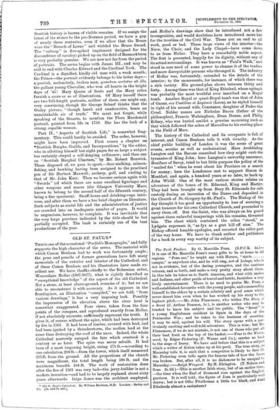OLD ST. PATJL'S.*
THIS is one of the occasional "Portfolio Monographs," and fully supports the high character of the series. The material with which Canon Benham had to work was fortunately ample; the pens and pencils of former generations have left many memorials of the exterior and interior of the Cathedral, and of these Canon Benham and his illustrators have made ex- cellent use. We have, thaflks chiefly to the Bohemian artist, Wenceslaus Hollar (1607-1677), what is rightly described as " exceptional knowledge " of the aspect of the old Cathedral. Not a stone, at least above-ground, remains of it; but we are able to reconstruct it with accuracy. As it appears in the frontispiece, an illustration "compiled," we are told, "from various drawings," it has a very imposing look. Possibly the impression of its elevation above the river level is somewhat exaggerated. Four views, taken from the four points of the compass, and reproduced exactly from Hollar, if not absolutely accurate, sufficiently represent the truth. It gives it, of course, without the spire, which had been destroyed by fire in 1561. It had been of timber, covered with lead, and had been ignited by a thunderstorm, the molten lead at the same time destroying the roof of the nave. Indeed, the whole Cathedral narrowly escaped the fate which overtook it a century or so later. The spire was never rebuilt. It had been of a most imposing height, rising 175 ft.—according to one calculation 204 ft.—from the tower, which itself measured 285 ft. from the ground. All the proportions of the church were magnificent, the total length being 586 ft. and the maximum breadth 104 ft. The work of restoration done after the fire of 1561 was very bad—the jerry-builder is not a modern invention—and had to be largely replaced about sixty years afterwards. Inigo Jones was the architect employed, • Old St. Paul's Cathedral. By William Benham, D.D. London : Seeley and Co. De. and 7a. net.] and . Hollar's drawings show that be introduced not. a lew incongruities, and would doubtless have introduced .more but
for the troubles of the Civil War. These put an end to all work, good or bad. Three large views of the interior—the Nave, the Choir, and the Lady Chapel—have come down
to us from Hollar. They have a remarkably noble aspect. The first is presented, happily for its dignity, without any of its actual surroundings. It was known as " Paul's Walk," and stood in sore need of some power to cleanse it of the traders and more disreputable persons who thronged it. The industry of Hollar was, fortunately, extended to the details of the interior; to the monuments, for instance, of which there was a rich variety. His ground-plan shows between thirty and forty. Among these was that of King Ethelred, whose epitaph was probably the most truthful ever inscribed on a Royal tomb. Another Royal or quasi-Royal tomb was that of John of Gaunt, rex Castiliae et Legionis (Leon), as he styled himself in right of his second wife, Constance, daughter of Pedro the Cruel. Nobler names are Nicholas Bacon (father of the philosopher), Francis Walsingham, Dean Donne, and Philip Sidney, who was buried amidst a genuine mourning such as that which followed the ashes of Marcellus to his resting-place in the Field of Mars.
The history of the Cathedral and its occupants is full of interest, and Canon Benham tells it with vivacity. As the chief public building of London it was the scene of great events, secular as well as ecclesiastical Here Archbishop Langton and the Barons consulted how they might curb the tyrannies of King John; here Langton's unworthy successor, Boniface of Savoy, tried to but little purpose the policy of the " mailed fist " when he went about his Province on a search for money; here the Londoners met to support Simon de Montfort, and again, a hundred years or so later, to back up John Wiclif. One of the most curious stories relates an adventure of the bones of St. Edmund, King and Martyr. They had been brought up from Bury St. Edmunds for safe custody during an incursion of the Danes and deposited in the Church of St.-Gregory-by-St.-Paul's. The Bishop of the day thought it too good an opportunity to lose of securing a great treasure for bis own Cathedral Church, and proceeded to carry them off. But the Saint, who was always on his guard against these unlawful tamperings with his remains, thwarted him. The chest which contained the relics " stood," as Lydgate expresses it, "as fyx as a gret hill off ston." The Bishop offered humble apologies, and escorted the relics part of the way home. We have to thank author and publishers for a book in every way worthy of its subject.






















































 Previous page
Previous page